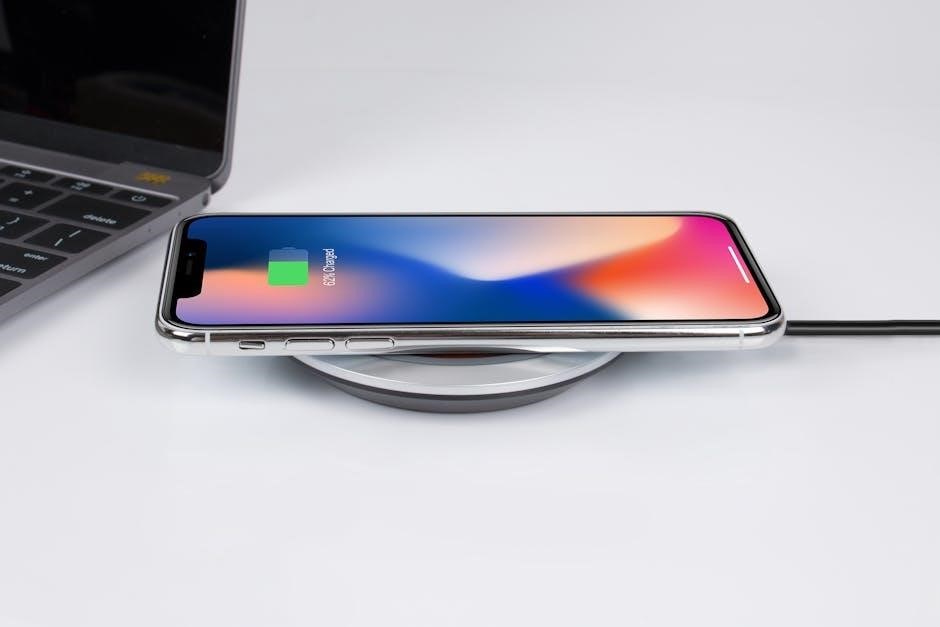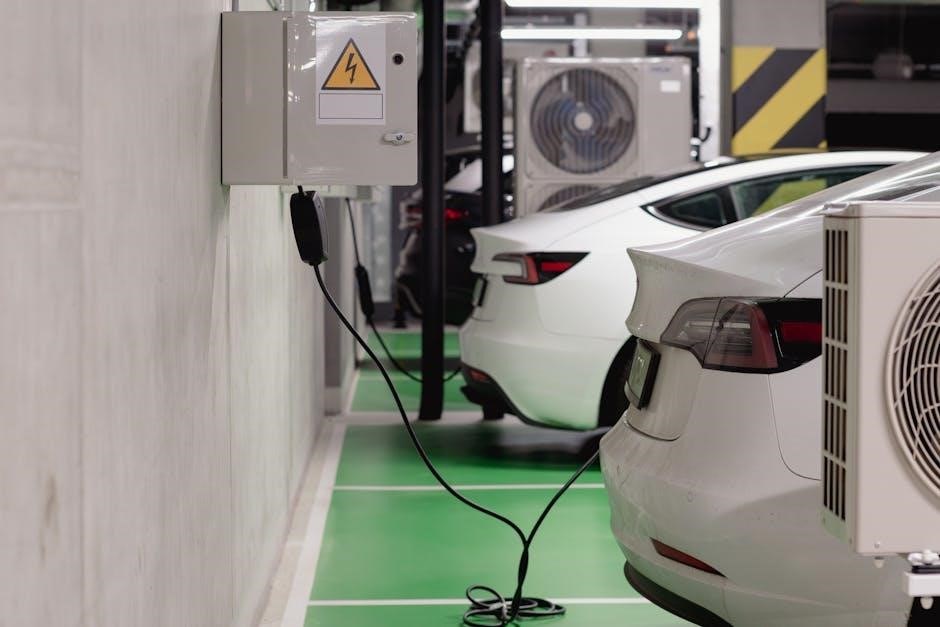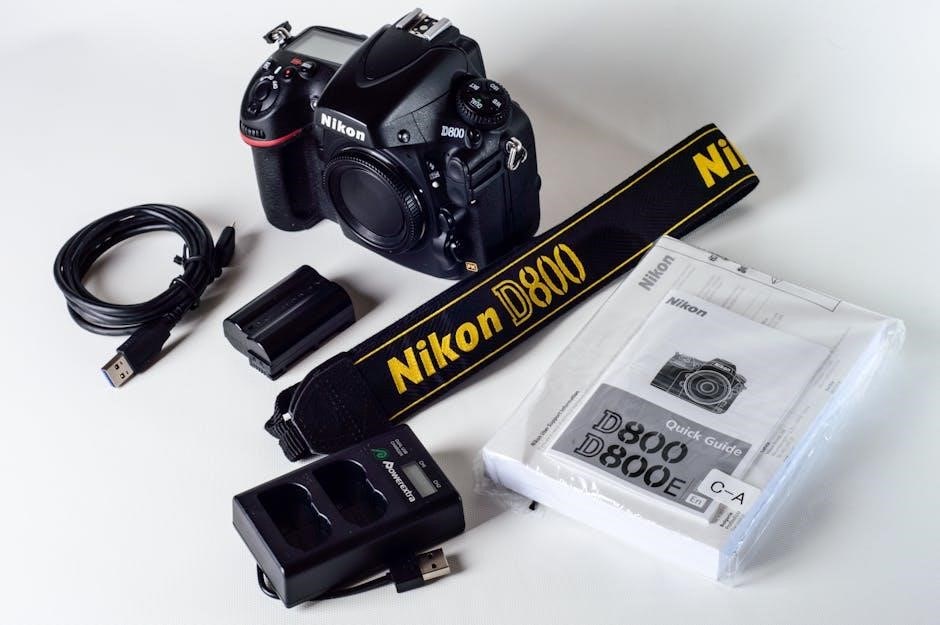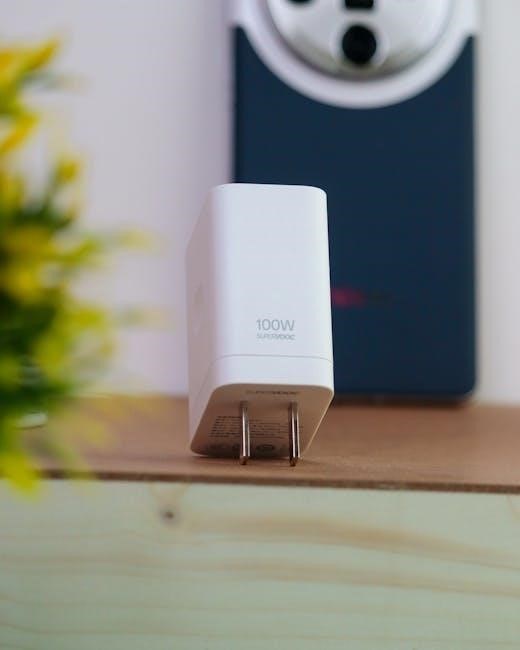
Safety Precautions and Instructions
Always follow safety guidelines when handling batteries and chargers. Avoid sparks and open flames near batteries. Ensure proper ventilation during charging. Never charge frozen batteries. Read the manual thoroughly before use.
- Keep flammable materials away from charging areas.
- Wear protective gear when handling batteries.
- Disconnect batteries before servicing or storing.
Failure to comply may result in fire, explosion, or electrical hazards. Adhere to all warnings and instructions provided in the manual to ensure safe operation.
1.1. Battery Safety Information
Always handle batteries with care to prevent damage or hazards. Avoid exposing batteries to sparks, flames, or smoking materials. Ensure proper ventilation during charging to prevent gas buildup. Never charge a frozen battery, as it may cause internal damage. Inspect batteries regularly for signs of wear or damage. Use only compatible battery types as specified in the manual. Keep batteries away from children and unauthorized personnel. If a battery is damaged, discontinue use immediately. Failure to follow these guidelines may result in fire, explosion, or electrical hazards. Always adhere to the manufacturer’s instructions for safe battery handling and charging practices.
1.2. Charging Precautions
Always follow proper charging procedures to ensure safety and efficiency. Before charging, inspect the battery and charger for damage. Ensure all connections are secure and clean. Avoid charging in extreme temperatures or humid environments. Never overcharge the battery, as it may cause overheating or damage. Use only the charger specified in the manual for compatibility. Monitor the charging process to prevent timeouts or voltage issues. If the charger detects a problem, it may shut down automatically. Keep the charger and battery away from flammable materials. Proper charging practices help maintain battery health and prevent potential hazards.
1.3. General Safety Practices
Adhere to general safety practices to minimize risks while using the QuiQ battery charger. Ensure the charging area is well-ventilated and free from flammable materials. Avoid smoking or exposing the charger to open flames. Always wear protective gear, including gloves and safety glasses, when handling batteries. Do not touch electrical components with wet hands or while standing on conductive surfaces. Keep children and unauthorized individuals away from the charger and batteries. Regularly inspect the charger and battery for signs of damage or wear. Avoid overloading or using the charger beyond its rated capacity. Follow all manufacturer guidelines to ensure safe operation and prevent potential hazards.

QuiQ Battery Charger Features and Specifications
The QuiQ battery charger is a 1 kW industrial charger designed for high efficiency and reliability. It features a wide input voltage range, power factor correction, and compatibility with various battery types, making it suitable for global applications.
2.1. Input Voltage Range and Compatibility
The QuiQ battery charger operates on a wide input voltage range of 85 to 265 VAC, ensuring compatibility with various power sources worldwide. This versatility makes it ideal for both domestic and international applications. The charger’s universal design supports different electrical standards, allowing seamless operation across diverse regions. Its robust construction handles voltage fluctuations effectively, maintaining consistent performance. This feature is particularly beneficial for users requiring a reliable charging solution in areas with unstable power supply. The QuiQ charger’s adaptability enhances its utility across multiple environments and applications. Additionally, it is compatible with a range of battery types, including lithium and lead-acid batteries.
2.2. Power Factor Correction and Efficiency
The QuiQ battery charger is equipped with advanced Power Factor Correction (PFC), ensuring high efficiency and reliable operation. By maintaining a high power factor, the charger minimizes line current and reduces harmonic distortion, optimizing energy use and reducing strain on the electrical grid. This feature not only enhances overall efficiency but also contributes to a quieter operation and extended battery life, making the QuiQ charger a superior and eco-friendly solution for various battery charging applications.
2.3. Battery Type Compatibility
The QuiQ battery charger is designed to be compatible with a wide range of battery types, including lithium, lead-acid, and AGM batteries. This versatility ensures that the charger can be used across various applications, from electric vehicles to industrial equipment. The charger automatically detects the battery type and adjusts its charging parameters for optimal performance. It supports multiple charging algorithms, making it suitable for different battery chemistries. This adaptability ensures efficient and safe charging, extending battery lifespan and maintaining performance across diverse use cases. The charger’s compatibility is a key feature for versatile and reliable battery management.

Installation and Setup Guidelines
Ensure secure mounting and proper ventilation during installation. Configure settings according to the manual for optimal performance. Refer to the user guide for specific model instructions.
3;1. Mechanical Installation Requirements
Ensure the charger is installed in a well-ventilated area, away from direct sunlight and moisture. Mount the device securely on a stable surface using the provided hardware. Avoid over-tightening to prevent damage. Maintain a minimum clearance of 10 cm around the charger for proper airflow. Use appropriate fasteners suitable for the mounting surface. Ensure all electrical connections are secure and comply with local regulations. Refer to the manual for specific torque specifications and alignment guidelines to guarantee safe and optimal operation. Proper installation is crucial for reliability and longevity of the charger.
3.2. Initial Setup and Configuration
Connect the charger to the battery following the polarity guidelines in the manual. Plug in the AC power cord, ensuring the outlet meets voltage requirements. Use the control panel or remote interface to select the correct battery type and charging mode. Set the charge current and voltage limits according to the battery manufacturer’s specifications. Verify all connections are secure and the system recognizes the battery. Cycle the power if the charger does not initialize automatically. Once configured, test the charger at a low current to ensure proper operation before full charging. Always refer to the manual for specific setup instructions.

Troubleshooting Common Issues
Common issues include charge timeouts due to high temperatures or incorrect battery type. Check connections for loose wires and ensure proper ventilation. Restart the charger if necessary.
4.1. Charge Timeout and Battery Voltage Issues
Charge timeout occurs when the battery pack doesn’t reach the required voltage within the specified time. This can happen due to high temperatures, improper connections, or incorrect battery type settings. Check the battery voltage and ensure it matches the charger’s specifications. Verify all connections are secure and not corroded. If the issue persists, restart the charger or consult the user manual for reset procedures. Ensure the charger is operating within its thermal limits and that the battery is not damaged. Refer to the troubleshooting guide for detailed diagnostic steps.
4.2. Connection and Charger Output Problems
Connection issues or incorrect charger output settings can disrupt charging. Check all electrical connections for tightness and cleanliness. Verify the charger is configured for the correct battery type and voltage. Loose or corroded connections may cause intermittent charging or no output. Ensure the charger is properly grounded and that the input power supply is stable. If the charger fails to output power, check for blown fuses or tripped circuit breakers. Consult the manual for reset procedures or contact support if issues persist. Proper connection and configuration are essential for reliable charger performance.
4.3. Thermal Protection and High-Temperature Shutdown
The QuiQ battery charger features thermal protection to prevent overheating. If the charger detects high temperatures, it may reduce output or shut down to protect components. Ensure good airflow around the charger and avoid operating it in extreme heat. Check for blockages in ventilation openings and verify that the cooling system is functioning properly. High ambient temperatures or faulty cooling fans can trigger thermal shutdown. Allow the charger to cool down before resuming use. Consult the manual for temperature specifications and maintenance tips to prevent thermal-related issues.

Specific Models and User Guides
Refer to model-specific guides for detailed instructions. The E-Z-GO QuiQ Lithium Charger and World Charger user guides provide tailored information for respective models. Use the manual for your charger for accurate setup and troubleshooting.
- E-Z-GO QuiQ Lithium Charger User Guide.
- E-Z-GO QuiQ World Charger User Guide.
- Model-specific instructions for 913-4810-E3/E5/01/02 chargers.
5.1. E-Z-GO QuiQ Lithium Charger User Guide
The E-Z-GO QuiQ Lithium Charger User Guide provides detailed instructions for specific models, including the QuiQ Lithium Charger for E-Z-GO TXT and RXV golf carts. Designed for compatibility with lithium batteries, this guide covers initial setup, charging procedures, and troubleshooting. It includes model-specific configurations and safety protocols tailored to lithium technology. Refer to this manual for proper installation and operation to ensure optimal performance and longevity of your charger and battery system. Adhering to the guide is essential for safe and efficient charging.
5.2. E-Z-GO QuiQ World Charger User Guide
The E-Z-GO QuiQ World Charger User Guide is tailored for global compatibility, supporting a wide input voltage range of 85–265 VAC. This manual provides specific instructions for models designed for international use, ensuring adaptability across different power standards. It includes detailed setup, operation, and troubleshooting steps, optimized for various battery types. The guide emphasizes safety features and charging algorithms unique to the World Charger series, ensuring reliable performance worldwide. Following the manual’s guidelines is crucial for maximizing efficiency and maintaining the charger’s longevity in diverse electrical environments. Proper usage ensures safe and efficient battery charging.
5.3. Model-Specific Instructions for 913-4810-E3/E5/01/02 Chargers
For models 913-4810-E3, E5, 01, and 02, this section provides detailed, model-specific guidance. It covers unique features, settings, and troubleshooting tailored to these chargers. Instructions include initialization steps, compatibility checks, and error resolution. Users are advised to follow these guidelines to optimize performance and prevent issues. The manual also addresses specific charging algorithms and safety protocols for these models, ensuring safe and efficient operation. Adhering to these instructions is crucial for maintaining warranty validity and ensuring longevity of both the charger and battery. Proper setup and configuration are emphasized for optimal results.
 merlin home transmitter manual
merlin home transmitter manual  geography textbook activity manual pdf
geography textbook activity manual pdf  scope buddy plus user manual
scope buddy plus user manual  hibbeler mechanics of materials solution manual
hibbeler mechanics of materials solution manual  2015 buick enclave dvd player manual
2015 buick enclave dvd player manual  katalic cat feeder manual
katalic cat feeder manual  king of the underworld rj kane pdf
king of the underworld rj kane pdf  contrat de sous-location québec pdf
contrat de sous-location québec pdf  mark cousins the story of film pdf
mark cousins the story of film pdf